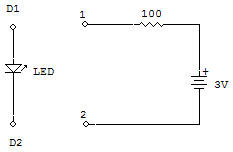
LED - A Special Diode

We've used LEDs in a number of earlier circuits. But just what is a LED anyway?
"LED" stands for "light emitting diode." It is indeed a diode, but a very special one. This Project will show just how a LED works.
Take the two long wires from Terminals 1 and 2 and touch diode terminals with them. When do you make LED 1 light?
When the long wire from Terminal 1 is touching terminal D1 and the long wire from Terminal 2 is touching D2, LED 1 will light up.
Remember when we said that a diode can conduct only in one direction? When-a LED is conducting, it gives off light. When electricity is applied from the opposite direction, it won't conduct nor does it give off light.
Each diode has two parts inside: an anode and a cathode.
In the schematic the anode is the "arrow" while the cathode is the straight line within the diode symbol. Electricity flows from the cathode to anode, This is called forward bias by electronics engineers.
When electricity is applied in the opposite direction (and the diode won't work), this is called reverse bias. Be careful and don't apply too much reverse bias to a diode — it could be damaged. That's why you'll notice we always add a resistor in series with a LED. LEDs are widely used in electronic circuits in place of lamps because they use little current and don't bum out like lamps do.
